
Advertisements on traditional media like TV, radio, print, and billboards are very familiar to all of us. We’re used to the bold visuals, engaging videos and catchy jingles that are crafted to embed themselves firmly in our consciousness.
For consumers of those advertisements, the way they’re supposed to work is that you see or hear them often enough that when a time arises that you need such a product or service you have a brand name to turn to.
For law firms – or any business – advertising on traditional media, it usually is a long-term marketing strategy, the goal being to create sufficient brand awareness that leads to future transactions.
Digital advertising, on the other hand, comes in many different forms, and provides more immediate opportunities to satisfy both the needs of a business that wants to close a deal quickly, and customers who need their products or services.
However, while digital advertising is ubiquitous in the internet-connected world of today, there is still a lot of mystery about how it all works and how businesses can leverage it successfully.
So, what is digital advertising, and how can you use it strategically to grow your law firm?
What Is Digital Advertising?
Digital advertising is any advertising that takes place on internet-based, digital platforms.
Those platforms include search engines, websites, business directories, map services, email services, mobile apps, games, video services, podcasts, and social media.
The term digital marketing is often erroneously used as a synonym for digital advertising, but digital marketing is an all-encompassing term that describes the multitude of things that you can do to create awareness for your business in the digital space. Digital advertising is only one of those things.
Is Digital Advertising Beneficial for Lawyers?
Digital advertising can provide great benefits to lawyers. It can be a critical component of an overall digital marketing strategy to help grow law firms.
If a digital advertising campaign is executed properly, on the right platforms, it can lead to immediate – albeit temporary – visibility for a law firm, and help to generate quick leads.
Digital advertising can also be used to build long-term brand awareness.
However, it’s not free. There is always the cost of the ad spend, which can get quite expensive for legal advertising in most markets.
The goal with digital advertising for a law firm should always be to execute it as strategically and cost-effectively as possible, so that the expenditure makes sense when matched with the return on the investment.
So, how do you execute a strategic digital advertising campaign for your law firm? To ensure success and the best ROI, you will need to have a firm understanding of the following:
- The different types of digital advertising models in play.
- The different types of platforms where you can advertise your law firm, and how to pick the best ones.
- How to define your digital advertising goals.
- How to craft effective ads that inspire users to act.
- How to ensure that your landing page or website doesn’t sabotage your ad campaign.
- How to set realistic advertising budgets.
Let’s dive into these topics.
What Are the Different Types of Digital Advertising Models?
There are several advertising models that are often used on digital platforms.
The most common are pay-per-click, pay-per-lead, and pay-per-impression.
Pay-per-click (PPC) Advertising
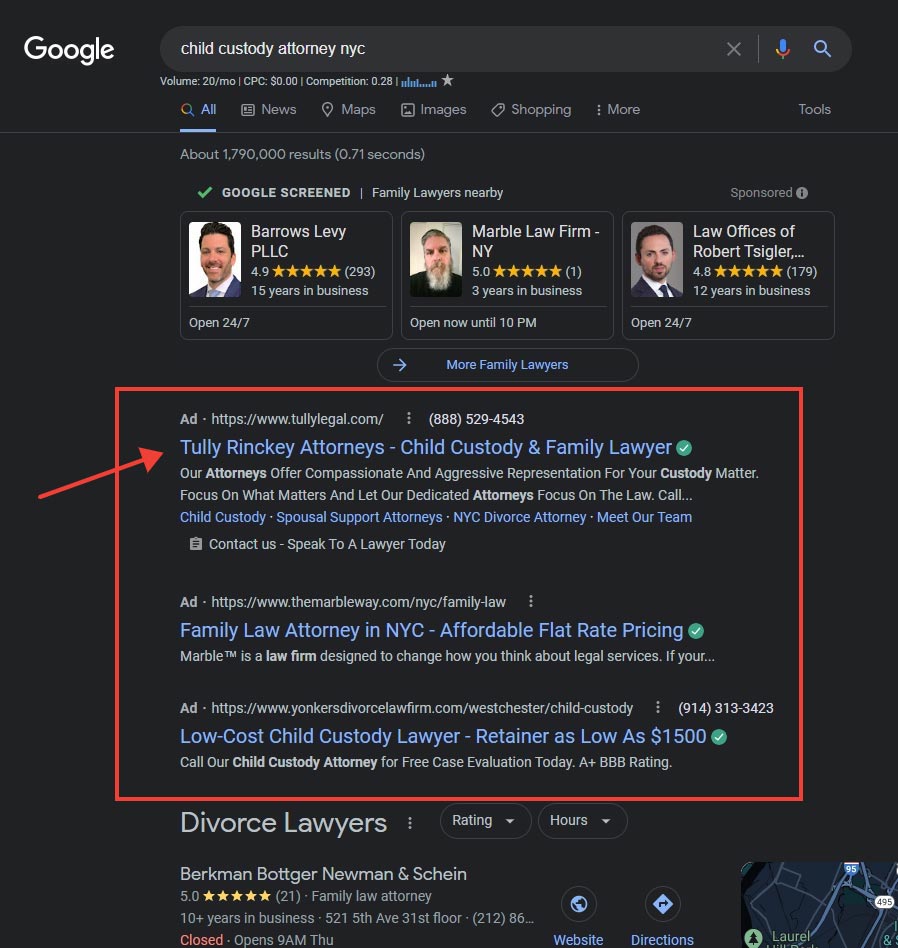
Pay-per-click advertising on Google search
Pay-per-click or PPC advertising is probably the most well-known digital advertising model.
With PPC advertising, you only pay the advertising fee to the publisher of the advert when a user clicks on your ad.
The PPC model is used by many publishers, across the spectrum of digital platforms – search engines, display ads on websites, social media, apps, etc.
With this model, the deliverable for the publisher of the ad is that your advertisement is clicked on by a user.
The fee for this advertising model is usually established by an automated auction system where advertisers bid on specific keywords or phrases to trigger the display of their ads. The auction system also determines other key features of the ad, like the prominence of its display and duration.
Pay-per-lead (PPL) Advertising
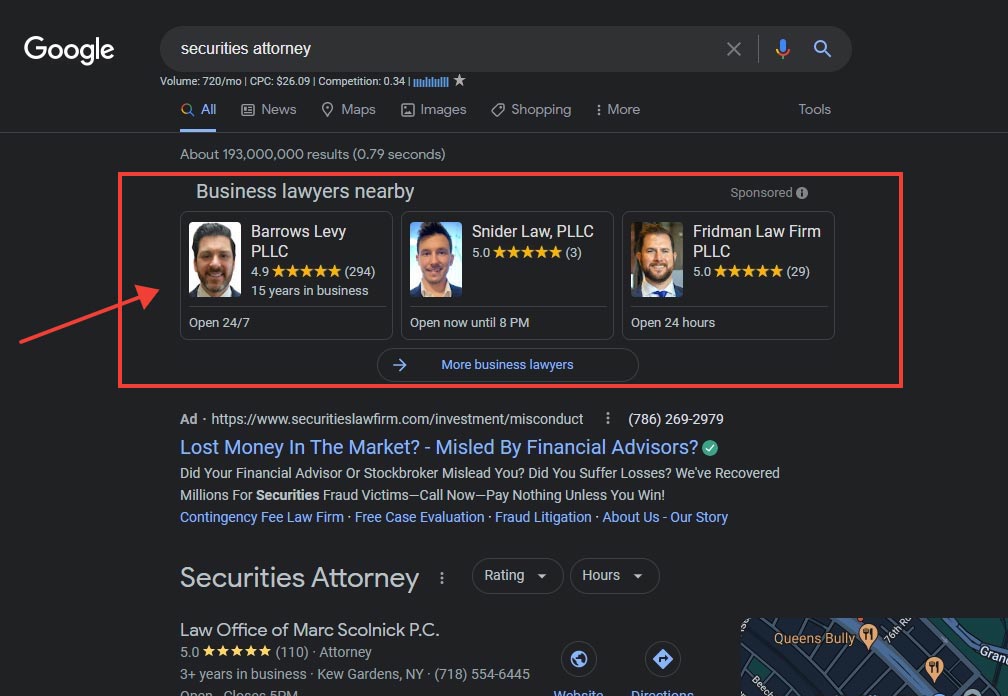
Pay-per-lead lawyer advertising on Google search
Pay-per-lead or PPL advertising is another model that’s used by some publishers on a variety of platforms.
The deliverable for a pay-per-lead ad is for the user to contact the advertiser, usually via trackable calls or email messages, indicating interest to engage their services.
That initiation of communication with the advertiser – by the platform’s user – is the key difference between pay-per-lead and pay-per-click advertising.
Pay-per-lead advertising in this sense should not be confused with the use of client referral services that you pay for. Any kind of situation where you are paying for a fully qualified client or referral by any means is not allowed under the rules of attorney advertising and client solicitation for almost all jurisdictions in the US.
The distinction between PPL advertising and illegal client referral services is that with PPL you place a legitimate advert, and only pay the publisher of that advert when an autonomous user decides to contact you based on your advertising.
With paid referral programs, you typically do not place any ads for your law firm. You get referred clients by the service when you register with them. You then have to pay for those referrals.
With PPL, you’re paying for advertising that leads to a possible client contacting you, with no promise of a closed transaction. With referral services, you’re paying a finder’s fee.
The American Bar Association and almost all local bar associations across the US consider paying for a referral an ethical violation. It can expose you to disciplinary actions.
An example of pay-per-lead advertising is Google Local Services Ads.
On average, PPL advertising tends to be the most expensive model. However, the return on investment is usually higher.
It is often the best ad model for immediate client acquisition for a law firm.
Pay-per-impression (PPI) Advertising
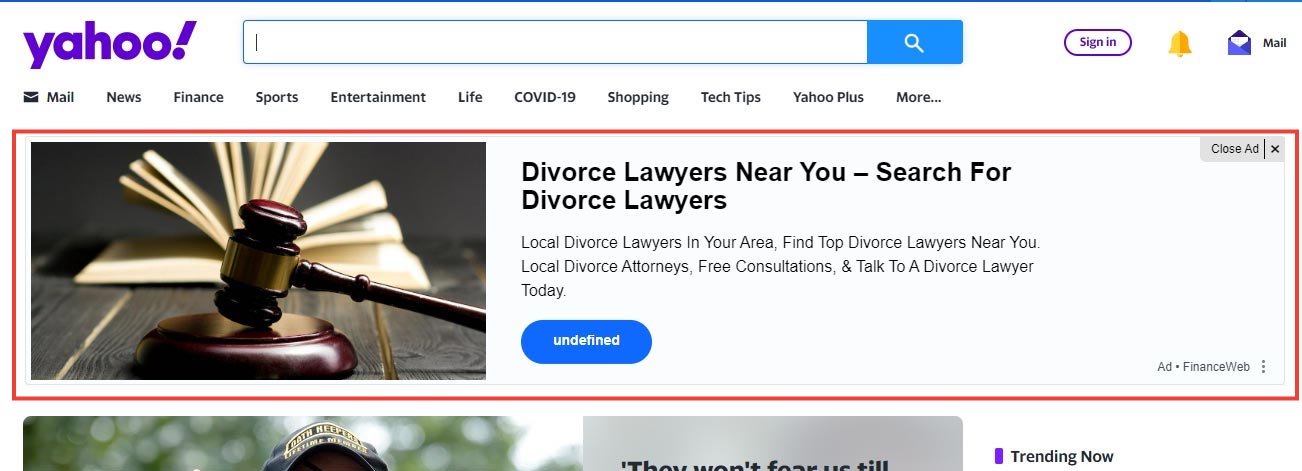
Pay-per-impression advertising on Yahoo homepage
Pay-per-impression or PPI advertising, also known as Cost-per-impression (CPI) or Cost-per-mille (CPM) is another digital advertising model that’s more prevalent with display advertisements on popular websites and apps.
With this model, an advertiser pays for the number of users who see the ad – usually grouped in the thousands of users.
It’s a carry-over from traditional media advertising, where a publisher guarantees an audience of a certain size, and the advertiser pays for those eyeballs.
The deliverable for a PPI ad is simply for it to be displayed to a user when they visit a webpage, app, or any other digital interface where it’s presented. No further action is guaranteed.
PPI ads are typically cheaper than most other models and are usually best for building brand awareness. It’s also a good model for retargeting or remarketing to past visitors, which we’ll discuss later in this post.
What Are the Different Types of Platforms for Digital Advertising?
As mentioned earlier, there’s a plethora of digital platforms where advertising proliferates.
It’s almost impossible not to encounter advertising in one form or the other while browsing the internet. Virtually every publisher of content that garners some eyeballs is trying to monetize that content with digital advertising.
While some platforms straddle several categories, the vast majority of properties online clamoring for your advertising dollars can be grouped into a few general categories: search engines, popular independent websites, business directories, video services, podcasts, mobile apps, games, and social media.
The overarching rule that should guide your decision whether or not to advertise on any platform is whether your target audience uses that platform. Despite the popularity of any digital platform, your audience or ideal client profile (ICP) might not frequent that platform in sufficient numbers or with any regularity to warrant an ad spend there.
And while there are many platform options for digital advertising, we’ll focus on the most important ones that lawyers and law firms should be targeting heavily with advertising: search engines, popular websites, business directories, video services and podcasts, and social media.
Advertising Your Law Practice on Search Engines AKA Search Engine Marketing
If you’ve ever heard the term “Search engine marketing” or SEM, it’s simply a fancy way to describe the act of advertising on search engines.
It involves buying ad placements on search engine results pages (SERPs), which are triggered when search users perform specific searches using keywords or key phrases that you bid on with a PPC or PPL ad campaign.
SEM is distinct from search engine optimization (SEO) which is a combination of strategies that you use to get the highest placements on search engine results pages without having to pay the publisher, which in this instance would be the search engine.
Every major search engine, like Google and Bing, has its own advertising business.
Advertising on search engines is generally the most targeted and effective strategy for client acquisition for lawyers. This is because search is intent-driven. Search users are looking for something specific that’s related to your advertisement, if you’ve correctly selected the right keywords to bid on.
This means they’re more likely to engage with your ad, as opposed to a situation where it’s presented to them out of context, and possibly in an intrusive or disruptive manner.
How to Successfully Advertise Your Law Firm on Search Engines
For successful SEM campaigns, you have to bid on the right keywords and phrases that have the most relevance to your business.
You’ll also need to have competitive budgets for your bids to get prime placements for your ads.
Then, the content of those ads must be highly optimized to encourage viewers to act.
Finally, for best results, the landing page or website that you want to drive traffic to needs to be properly optimized and relevant to your advertising.
Using tools that help with keyword research and give you a realistic idea of the cost per click or cost per lead pricing for your keywords and target market will be invaluable.
The goal should always be to spend only as much as you need to, and no more. Anything beyond that simply drives up the price for all advertisers in that market and diminishes the ROI on your ad expenditure.
The following keyword research tools will be invaluable:
Keyword Research Tools
Advertising Your Law Firm on Popular Websites
Almost any website on the internet will take your money and slap your advertisement on their web pages.
These websites run the gamut, from popular blog sites to massive web portals that serve their content to a huge audience.
The advertising models that are most often used on websites are PPC and PPI display advertisements. These are usually in the form of banner ads, placed strategically on web pages.
However, just because a website has a large audience and offers advertising , doesn’t mean it’s going to be the best fit for your law firm.
Besides the amount of traffic a website gets, the deciding factor to advertise on that site should be that its audience aligns with your ideal client profile (ICP).
Niche-focused sites that target a specific audience often provide the best advertising opportunities. An example would be a Trust & Estates Law Firm advertising on a popular website that caters to a senior audience.
Before signing up with any website and handing over your hard-earned dollars, research their traffic numbers and audience demographics to be sure that it’s a good fit.
Advertising Your Law Firm on Business Directories
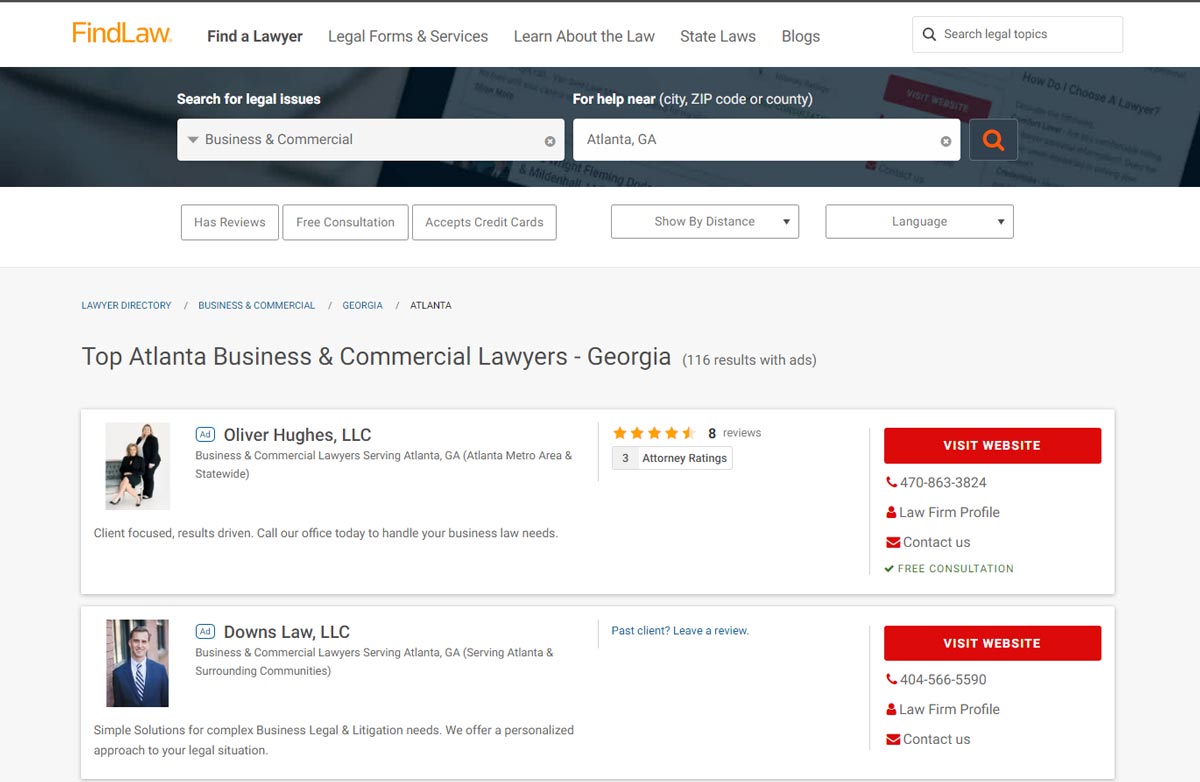
Lawyer ads on a legal business directory
Just like websites, there are many business directories that sell advertising.
Google business profiles, is probably the most well-known example of such a service. In the legal niche there are several like Avvo, Findlaw, and Justia, to name a few.
Legal directories are extremely popular with lawyers, who often visit them. If you get a lot of referral business from other lawyers, it makes sense to have a premium listing or advertisement on sites like Avvo, Findlaw, Justia, etc.
Additionally, these directories often do well in search results for some query types, so premium ads on them will help you get more visibility among other lawyers, if a search user is directed to them.
At the very least, it is advisable to maintain a basic profile on platforms like these.
Advertising Your Law Firm on Social Media

Advertising on social media
Social media platforms are enormously popular, and their use is pervasive. Whether it’s Facebook, Instagram, Twitter, Snapchat, TikTok or LinkedIn, we all spend an inordinate amount of time every day on our favorite social platforms.
And so do some of your target clients.
As always, the primary consideration for advertising on any social media platform should be whether your target audience uses that platforms in sufficient numbers to justify advertising. While a platform might be very popular and have a large audience overall, that audience might be totally irrelevant to your practice.
For instance, with the core demographic of TikTok users being Gen Z and younger, it might not be the best platform for a Trust & Estates attorney to advertise on. However, it might be perfect for attorneys who specialize in cases related to academic misconduct or alcohol and drug violations in school settings, etc.
LinkedIn, as another example, would obviously be a prime location for Employment attorneys to advertise.
It’s also very important to assess whether you’ll have the ability to precisely target a demographic profile on the social media platform you’re thinking of advertising on. With growing privacy concerns and resulting legislation in many jurisdictions, it’s increasingly harder to laser-target your advertising to the specific subset of a social platform’s audience that your message is more likely to resonate with. However, some platforms do still provide a great deal of targeted access to their users. On those platforms, ad buys might be worth it.
Advertising Your Law Firm on Video Services & Podcasts
While there are many hosted video services providers, YouTube is probably the most popular standalone video service where you can advertise your legal practice.
It’s also the second largest search engine in the world, with billions of users searching the platform every day for content of all kinds.
The key to succeeding with video advertising lies in successfully pairing your ads with popular content that caters to the kinds of audiences that are likely to be interested in your legal services.
This can happen in two ways. The first is, by signing up for the YouTube Ads program and having them pair your ads with relevant content that gets shown to precisely targeted users on the platform.
The second effective strategy is to seek out popular content creators on the platform, with a sizable following and an audience and subject matter that is in line with the legal services you provide, and directly sponsor their content.
A combination of both strategies will get your advertising in front of a huge audience and can help with both lead generation and building brand awareness for your law practice.
Similarly, with the increased popularity of podcasts of all kinds, it can be advantageous to advertise on popular podcasts with the right audience demographic, or to use the advertising platforms of popular podcast hosting services for ad placements.
Defining Your Digital Advertising Goals
Before embarking on any digital advertising campaign, it’s important to define the goals you’d like to accomplish.
Establishing clear objectives for your advertising will dictate your strategy and the platforms that you choose to advertise on.
The two most common advertising goals for law firms are lead generation and creating brand awareness.
With the former, the objective is immediate client acquisition, and with the latter, the objective is driving traffic to your website to create brand awareness.
If immediate client acquisition is the goal, it’s best to focus your ad spend on pay-per-lead and search-based marketing campaigns.
For building brand awareness, pay-per-impression display advertising is a better and more economical option.
A solid digital advertising campaign should ideally address both goals, even though it might be weighted more heavily on one side. In such a scenario, allocate the majority of your ad budget to the primarily goal, and the remainder to the secondary goal.
Working With Advertising Networks
For the most part, the discussion so far has been based on a scenario where you are contracting with publishers directly and paying for advertising on individual platforms.
Often what happens is that you’ll be using an advertising network, and they’ll promote your advertisements on their network of properties online, along with those of their partners.
A prime example of this is if you’re using a service like Google Ads. Google Ads are propagated on their search engine and some of their other properties like YouTube, partner websites and partner ad networks. Microsoft Ads and Audience network is similar.
With networks like these, besides the search engine that may be the primary property you wish to advertise on, your ads may also be displayed on other properties they own or partner with. Those other properties will typically be the types we’ve already covered like partner websites, video services, apps, etc.
You often will be able to decide if you’d like to allocate all your advertising budget to be spent advertising on the search engine results pages, or to have it split with display advertising on partner networks.
If you opt to display advertising on partner networks in addition to search, you will have your ads showing up on partner websites, video services, and other properties that the ad network may own.
This may not always be what you want or need. Your advertising goals – lead generation or brand awareness – should dictate how you allocate your budget when using advertising networks.
It’s therefore very important to understand where and under what circumstances your ads will be showing up, how that aligns with your advertising goals, and how that may impact your overall budget when you use advertising networks for your campaigns.
As much as possible, you want to avoid any wasted advertising. This can occur very easily if your ads automatically get thrown on-to properties with the wrong audience. In such a scenario, if the ads are presented intrusively, those users may click on them just to get them out of their way, without having any interest in what you’re offering. This will deplete your ad budget and will work against you, while working to the advantage of the publisher.
How to Create Effective Ads
We’ve covered a lot of topics so far, but your advert itself is a critical part of the equation.
While the exact format – the size and dimensions for the ad, permitted character or word lengths, color formats, etc. – will vary based on the particular requirements for each platform, the content overall has to be properly crafted to resonate with your target audience.
Your ad copy, headlines and overall message must be clear, direct, and succinct. If you’re using images and graphics to help sell your message, they must be relevant to what you’re trying to convey.
All the texts in your ad must be legible. This is particularly important if you’re using graphics with text or making video ads that have text displayed. Make sure that there is sufficient contrast between the image or video backgrounds you use, and the texts overlaid on them.
Many internet users already have trained themselves to ignore ads on the internet – a well-known phenomenon known as “Ad Blindness”. The harder you make your ads to read, the easier they are to ignore.
Finally, you must use clear calls to action that will motivate viewers of your ad to act.
The Importance of Having a High-Converting Landing Page or Website
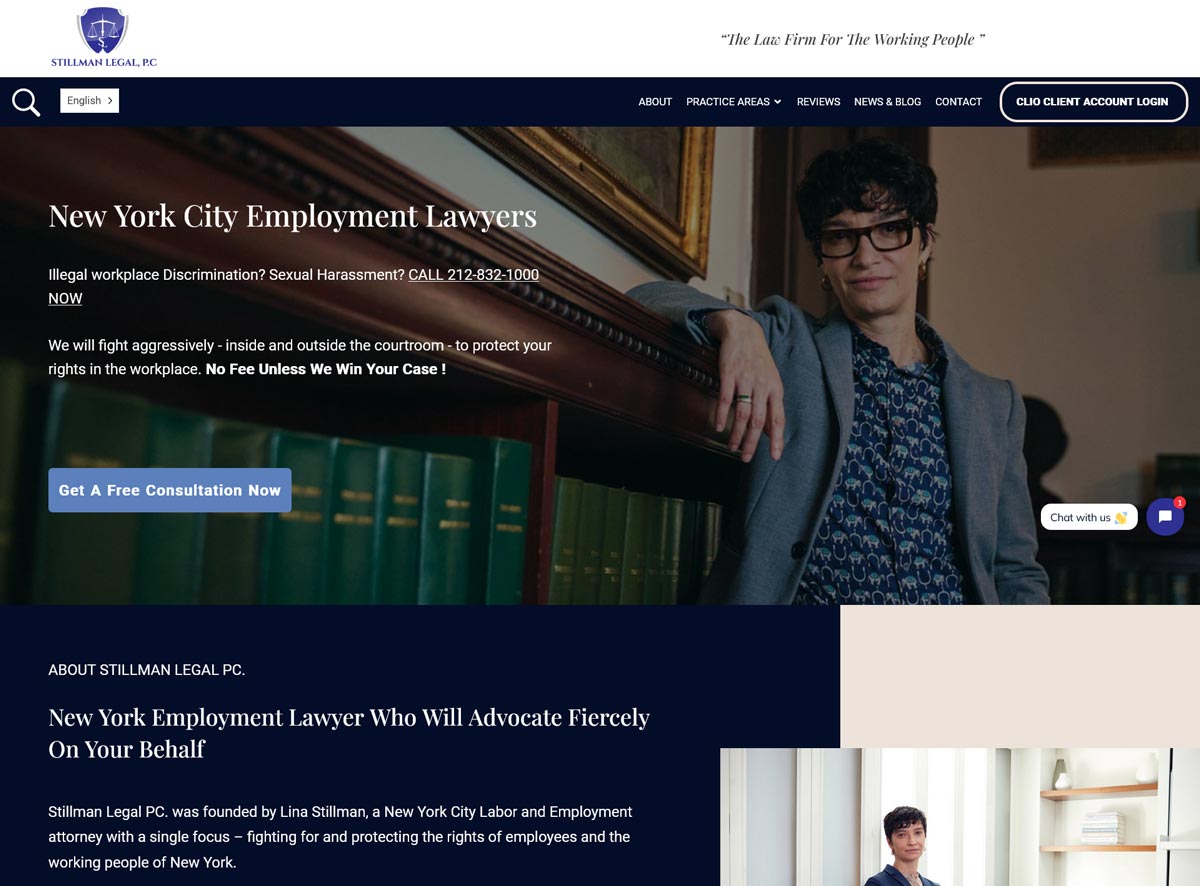
A professional, high-converting law firm website
If you’re running PPC search ads on networks like Google Ads and Microsoft Ads that drive visitors to a specific landing page or website, you must ensure that when they get there, they will find content that’s relevant to your advertising and that will get them to act – or in marketing terms, convert.
These networks use an automated auction system for PPC ads that factor in the quality of your landing page or website – among other things – to determine what it’ll cost you for every click on your ad, as well as the prominence your ads will get on the properties they’re displayed on.
As with most things to do with search engines, the exact details of the algorithms are secret, but the performance of your landing page is one of the components that is measured to establish what’s known as the Quality Score of your ad, and it is very impactful.
It’s not enough to simply throw the most money into your bids to have successful SEM campaigns. You could place the highest bids for your keywords and still lose out.
You need to always keep in mind that even though you’re paying for advertising on search engines, the search engines still want to take their users to legitimate destinations that are likely to give them the kinds of content they expect to find. That’s why you must make sure that everything from your ads to your landing page or website is properly optimized and relevant.
Besides the impact on your Quality Score, it’s a wasted exercise to throw money on advertising if the traffic you generate is funneled to a landing page that will make visitors question your credibility, or that’s confusing or unprofessional, or totally unrelated to the offer in your advertising.
How to Establish a Realistic Budget for Your Digital Ad Campaigns
Legal advertising is extremely competitive in most US markets and bids for keywords and advertising rates can be quite high.
Several factors are behind this. One of those is simply the fact that there is a huge number of lawyers providing legal services in the US. Currently that number is about 1.3 million. Additionally, lawyers are constrained in the ways that they can market their services and solicit business. Advertising is one of the few avenues available to most law firms to raise awareness about their services.
As such, the demand for legal advertising is huge and often outstrips supply in some US markets, which only serves to drive up the cost of advertising in those markets. When that is coupled with inefficient advertising campaigns, where some players feel that the only solution is to throw as much money as possible into a campaign, you get a scenario where the cost of advertising continues to increase for every advertiser in that market.
For any advertising campaign to make financial sense, the cost of advertising has to match up with the return on investment in a meaningful ratio.
While specific amounts are going to vary widely based on your overall marketing budget, goals, and the market you’re operating in, a ratio of about 1:2.5 – with every ad spend of a dollar bringing in about two and half dollars in new business – is a realistic budget to start with.
As you plan your overall campaign, you need to monitor that ratio to see that it doesn’t start to dip lower. Regardless of the bid rates that some auction systems will suggest to you, prompting you to optimize your bids continuously by spending more and more, if you start to spend to the point where your ratio is approaching 1:1, you’ll be running a losing campaign with no ROI.
How to Mitigate Digital Advertising Fraud
In the digital advertising space, there are some fraud schemes that exist.
Most of these schemes typically affect PPC ads, and the most pervasive type is known as Click Fraud.
Given that with PPC advertising you pay the publisher every time a user clicks on your ad from their property, it’s easy to see why some publishers might be incentivized to get click-happy with your ads. With every click, they make more money. Some publishers deliberately practice fraud of this kind to make more money from you.
The same also happens when you contract with Ad networks like Google Ads or Microsoft Ads. These networks partner with millions of independent publishers all around the world who show those network-managed ads on their own websites and online properties and get a share of the ad revenue.
Most of these partner publishers are honest, but not all are scrupulous. Some employ very sophisticated schemes that involve software programs known as Click Bots that automatically click repeatedly on ads to inflate the revenue they receive.
There are some very large operations involving these Click Bots, known as Click Farms, that carry out these activities on a massive scale. There are also human operations, with enormous sweatshops in some parts of the world, that are devoted entirely to Click Fraud.
Not all click fraud schemes are so sophisticated. Sometimes it could be as simple as a malicious competitor repeatedly clicking on your ads, when they encounter them, to drain your ad budget.
It is a big problem. In 2020 alone, advertising fraud schemes like these cost advertisers $35 billion in losses globally.
Most honest publishers and ad networks are aware of these types of schemes and typically provide some tools to monitor for these types of nefarious activities. Most will also offer refunds in instances where you lose money to identified click schemes. Unfortunately, they can’t catch every instance.
On your part, you can be proactive and employ some specialized tools and services that monitor your campaigns and flag suspicious activity. There are several such services and they work in various ways. Some of the best are listed below:
Click Fraud Protection Tools
Digital Ad Retargeting
If you’ve done everything right and your ads are optimized and your landing page is great and you’re getting good click-through rates on your ads, you still might get some visitors who aren’t quite ready to commit.
They may just be shopping around or planning to engage later. You want to make sure they don’t forget about you.
Retargeting or remarketing is done by repeatedly showing your ads to users who have visited your landing page or website before but didn’t convert or complete a transaction at that time.
It’s an effective strategy to keep your firm in the consciousness of a potential client who may have been looking around for a lawyer but didn’t have an immediate need to hire one the first time they visited your website.
With retargeting, your ads are shown across the web on different properties to those visitors, and it can help to bring them back to act when they are ready.
Summary
Digital advertising can be a valuable tool in your marketing arsenal to help grow your law firm.
To succeed with digital advertising, you have to define clear goals and advertise on the right platforms that make the most sense for your practice.
Focus your advertising efforts on the platforms where the types of clients you’re looking for visit in large numbers, and make sure you’re running a strategic campaign that maximizes your budget to meet your advertising goals.